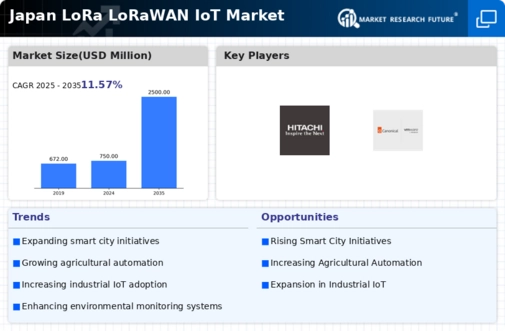Advancements in IoT Technology
The lora lorawan-iot market in Japan is experiencing a surge due to rapid advancements in IoT technology. Innovations in sensor technology and data analytics are enabling more efficient and effective applications across various sectors. For instance, the integration of AI with IoT devices is enhancing data processing capabilities, leading to improved decision-making. This technological evolution is projected to drive the market's growth, with estimates suggesting a compound annual growth rate (CAGR) of approximately 15% over the next five years. As businesses increasingly adopt IoT solutions, the lora lorawan-iot market is likely to expand significantly, catering to diverse applications such as smart logistics and environmental monitoring.
Growing Need for Real-Time Data
The increasing demand for real-time data across various industries is significantly impacting the lora lorawan-iot market. Businesses are recognizing the value of immediate insights for operational efficiency and customer satisfaction. For example, sectors such as logistics and manufacturing are leveraging IoT solutions to monitor processes in real-time, leading to reduced downtime and enhanced productivity. This trend is likely to propel the market forward, with projections indicating that the demand for real-time data solutions could increase by over 20% in the next few years. Consequently, the lora lorawan-iot market is positioned to benefit from this growing need.
Rise of Smart Home Technologies
The proliferation of smart home technologies is contributing to the expansion of the lora lorawan-iot market. As consumers increasingly seek convenience and automation in their living spaces, the demand for IoT-enabled devices is on the rise. In Japan, the smart home market is expected to reach ¥1 trillion by 2026, with a significant portion attributed to lora lorawan-iot applications. This trend is fostering innovation in home automation, security systems, and energy management solutions. As more households adopt these technologies, the lora lorawan-iot market is likely to see substantial growth, driven by consumer preferences for interconnected devices.
Government Support and Initiatives
Government initiatives in Japan are playing a crucial role in fostering the lora lorawan-iot market. Policies aimed at promoting digital transformation and smart infrastructure are encouraging investments in IoT technologies. The Japanese government has allocated substantial funding to support research and development in this field, with an estimated budget of ¥100 billion for IoT-related projects in the upcoming fiscal year. Such support not only enhances the technological landscape but also stimulates collaboration between public and private sectors. This synergy is expected to accelerate the deployment of lora lorawan-iot solutions, thereby driving market growth and innovation.
Increased Focus on Environmental Monitoring
The The market is also being driven by a heightened focus on environmental monitoring in Japan.. With growing concerns about climate change and pollution, there is a pressing need for effective monitoring solutions. IoT technologies are being deployed to track air quality, water resources, and waste management, providing valuable data for policymakers and businesses alike. The market for environmental monitoring solutions is projected to grow by approximately 18% annually, reflecting the increasing importance of sustainability. This trend is likely to enhance the relevance of the lora lorawan-iot market, as it offers robust solutions for addressing environmental challenges.













Leave a Comment